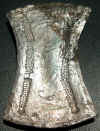A Southern Sung Axed with Inscriptions Fulfilling Monetary Requirements
Weight: 460 grams/12.5 taels
Date: N/A
Inscriptions: 京銷鋌銀/重拾貳兩半/京銷鋌銀 京銷鋌銀/霸東/黃范鋪/京銷鋌銀
Lump Silver cast in the CapitalWeighed Twelve and a Half Tael
Ba Dong (Street)
Huang and Fang's Firm (Silver shop)
The Southern Sung Dynasty (1127-1279 A.D.) had the misfortune of being one of the weakest and unluckiest regimes in the history of China. It was intimidated and periodically invaded by its hostile neighbors - Liao, Xi Xia, Jin and Mongolia, until being overthrown by the Mongolian troops of Kublai Khan. The Southern Sung, although being challenged politically and militarily, was distinguished by great social growth. The people of the dynasty developed their capital city- Ling An (Now, Hangzhou)- into the most flourishing and prosperous city over the world of that time.
The development of markets and the growth of commerce stimulated the economy and increased demand for currency. During the Southern Sung, both the minting of cash coins and the production of silver sycee reach record levels, and paper notes were created by merchants and then by the government to facilitate transactions and liquidity.
It was at that time sycee began to be widely accepted as a form of currency, and was no longer merely treated as a method for storing wealth by the elite class.
Circulating sycee as a currency required a well established management system consisting uniform weighing and silver fineness standards, and a casting industry which held each of its members accountable by law to those standards. The inscriptions on the above specimen shows how the Southern Sung sycee fulfilled those requirements.
The inscription of 京銷鋌銀 indicates that this piece was "Lump Silver" cast in the capital Ling An. "Lump Silver" is assumed to represent the finest silver at that time.
The inscription of 重拾貳兩半 denoted the weight of the sycee. Reportedly, during the Southern Sung, sycee was customarily cast in 3 sizes, the big ones in 50 taels, the medium ones in 25taels, and the small ones in 12.5 taels. This piece was a small one based on the Southern Sung's general system.
The inscriptions of 黃范鋪 and 霸東 respectively show the name of the silver shop which cast this sycee and its location. As such, it enabled a customer to hold the silver shop responsible for the sycee it cast.
Due to the social developments which allowed for the evolution of this management system, sycee was able to start competing with other currencies since the Southern Sung. This also paved the way to a broader circulation of sycee in later times.
Return to Sycee Talks
